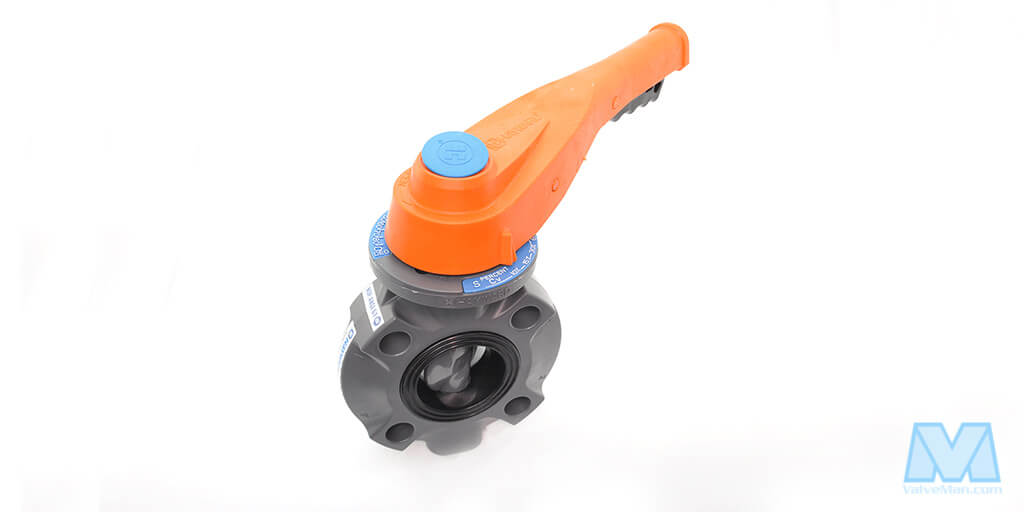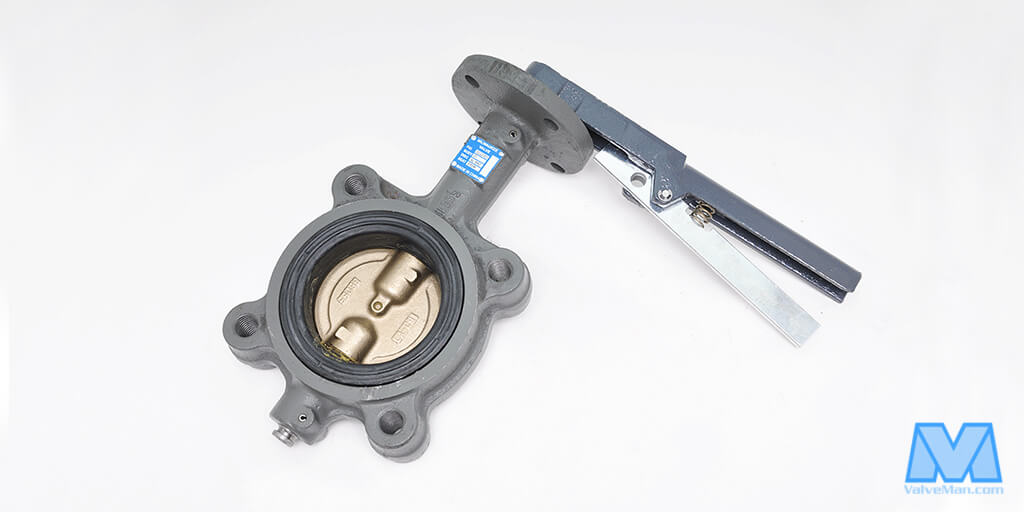
Manual
Manual Butterfly Valves
Shop Manual Butterfly Valves Shop Now
Electric
Electric Butterfly Valves
Shop Electric Butterfly Valves Shop Now
Pneumatic
Pneumatic Butterfly Valves
Shop Pneumatic Butterfly Valves Shop Now
Wafer
Wafer Butterfly Valves
Shop Wafer Butterfly Valves Shop Now
Lug
Lug Style Butterfly Valves
Shop Lug Style Butterfly Valves Shop Now
High Performance
High Performance Butterfly Valves
Shop High Performance Butterfly Valves Shop Now
Grooved
Grooved Butterfly Valves
Shop Grooved Butterfly Valves Shop Now
3-Way
3-Way Butterfly Valves
Shop 3-Way Butterfly Valves Shop NowButterfly valves are a useful component in many systems, resulting in them playing a vital part in many different industries. ValveMan carries a wide array of different butterfly valves, so let's take a closer look at their potential uses and advantages.

What Is a Butterfly Valve?
A butterfly valve is a specific type of quarter-turn valve that consists of two distinct components:
- A circular disc placed inside a pipe or duct
- A rod or shaft connecting the disc to the outer actuator or manual handle
When hand handle or actuator is turned, the shaft then turns the disc by a quarter turn to either open or close the valve.
How A Butterfly Valve Works
The butterfly valve is comprised of a body, seat, disc, stem, and actuator. Each of these components is available in a variety of materials and other options. It's important to properly combine these trim features from materials that will best suit the environment and service for which it's intended. The central disc of the body is known as the butterfly and is what gives this valve its name. This butterfly is mounted to the stem and when the valve is switched to the closed position, the butterfly rotates on the stem and prevents the passage of fluid or gas by nestling itself against the round seat of the valve's body. This provides a sound seal. To switch the butterfly valve into the open position, the butterfly is moved a quarter turn (hence its quarter turn classification) so that it faces 90 degrees from the seat to allow unrestricted flow of fluid or gas.
What Are the Common Applications of Butterfly Valves?
Butterfly valves are common and versatile, which makes it difficult to list all the places where they find use. Some of the common applications include the following:
- Water and Wastewater Treatment: Butterfly valves play a great role in both potable and non-potable water transportation. This includes sewage systems.
- HVAC Systems: AC and HVAC systems involve many types of cooling liquids and fuels. Butterfly valves play an important role in controlling these liquids and gases.
- Power Generation: Power generation plants often use butterfly valves to help control cooling liquids and fuels.
- Fire Protection Systems: Fire protection systems find the butterfly valve incredibly useful for the control of gases and liquids. Whether it's for controlling fire-retardant liquids or for regulating gases, butterfly valves fit the bill perfectly.

Butterfly Valves - Available Materials and Sizes
Butterfly valves come in a wide array of shapes and sizes, thanks to the wide variety of industries and uses in which they find purpose.
The different materials that butterfly valves are available in include the following:
- Carbon Steel
- Stainless Steel
- Cast Iron
- Epoxy Coated Cast Iron
- Epoxy Coated Ductile Iron
Some of the different size options include the following:
- 1-1/2"
- 2"
- 2-1/2"
- 3"
- 4"
- 5"
- 6"
- 8"
- 10"
- 12"
- 14"
- 16"
- 18"
- 20"
- 24"
They also come in a variety of different types and with varying actuators, including the following:
- Wafer Style
- Lug Style
- High Performance- Wafer Style
- High Performance- Lug Style
- Grooved End
- Manual
- Gear Operator
- Pneumatic- Double Acting
- Pneumatic- Spring Return
- Electric Actuator
What Are the Advantages of Using Butterfly Valves?
There are many advantages to using butterfly valves, including the following:
- Cost-Effective: Butterfly valves are generally inexpensive, making them ideal for even menial, low-cost projects.
- Compact and Lightweight: Thanks to their lightweight, compact construction, these valves add little weight to the overall weight of your system.
- Quick Operation: Due to the incredible simplicity of butterfly valves, they can operate almost instantly, making them ideal for use in industries that require precision calibration.
- Easy Installation and Maintenance: Butterfly valves fit between two flanges. So, installing a butterfly valve is easy, which makes them ideal for many industrial and municiple uses.
- Bubble-Tight Shut-Off: If you choose a high performance butterfly valve with the correct specifications and made from the right materials, it is not likelyleak when closed. This makes it ideal for systems that require watertight closure (like fire control systems).
- Wide Range of Applications: Thanks to their unique design, butterfly valves are applicable for everything from gases to liquids, making them highly versatile.
- Reduced Torque and Actuator Size: Butterfly valves require significantly less torque than many other valves, which means their actuators can be a fraction of the size, and therefore less expensive to operate.
Frequently Asked Questions (FAQs)
How Do I Select the Right Butterfly Valve for My Application?
When trying to find an appropriate butterfly valve for your application, there are a few things to bear in mind. Mainly, choose a material that won't react to the liquid or gas you're transporting. Secondarily, the size of the system. Finally, the type of actuator you need, whether manual, pneumtaic, or electronic. You should be fully aware of what you need before you try to buy butterfly valves.
Can Butterfly Valves Be Automated?
Yes, butterfly valves can certainly be automated. In fact, some of the butterfly valves we carry at ValveMan come are automated with electric actuators or pneumatic actuators.
How Should Butterfly Valves Be Maintained?
Butterfly valves generally require little to no maintenance. However, to ensure that it stays in working condition for as long as possible, you should inspect it regularly, ensuring that sediment and debris don't build up within it. You should also use it regularly to prevent the buildup of corrosion or other problems.
Where Can I Buy Butterfly Valves?
ValveMan stocks a broad range of different butterfly valves. For the best prices and choices, check out our butterfly valve collection. You may also want to take a closer look at some of our other collections, like high-pressure ball valves and inline check valves.
Butterfly Valves - Related Articles
Actuated Butterfly Valves 101: All You Need To Know About Their Application In Piping Systems
What is the Difference Between Lug and Wafer Type Butterfly Valves?